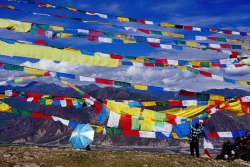Prayer Flag
The fluttering prayer flags can often be found along with piles of mani stones on rooftops, mountain passes, river crossings, and other sacred places. Prayer flags are actually colorful cotton cloth squares in white, blue, yellow, green, and red. Woodblocks are used to decorate the prayer flags with images, mantras, and prayers. Usually at the center of a prayer flag, there is an image of the Wind Horse which bears the Three Jewels of Buddhism. On the four corners of the flag, are images of Garuda, Dragon, Tiger, and Snow Lion which are the four sacred animals representing the four virtues of wisdom, power, confidence, and fearless joy respectively. Sometimes auspicious Buddhist symbols can be found on the edges. In the blank spaces between the images, prayers and mantras are printed.
There are two kinds of prayer flags, the horizontal ones called Lungta in Tibetan and the vertical ones called Darchor. Horizontal prayer flags are squares connected at the top edges with a long thread. The less used vertical prayer flags are usually single squares or groups of squares sewn on poles which are planted in the ground or on rooftops. Tibetans believe the prayers and mantras will be blown heavenward as offerings to their deities and will bring benefits to the one who hangs them, his neighborhood, and all sentient beings, even flying birds. However, if the flags are hung on the wrong astrological dates, they will bring only negative results. And the longer it hangs, the greater the obstacles which will arise. Old prayer flags are replaced with new ones annually on Tibetan New Year.
